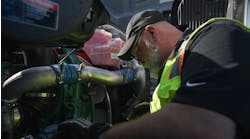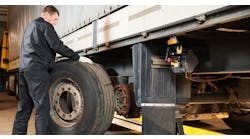The Compliance, Safety, Accountability (CSA) program for commercial trucks and buses from the U.S. Department of Transportation's Federal Motor Carrier Safety Administration has created a lot of confusion for the trucking industry when it comes to tires.
This bewilderment is resulting in truck fleets being “dinged” with CSA points for trucks found with undertinflated tires. Drivers of trucks with underinflated tires are receiving CSA points as well.
The problem is that while there are set definitions for a flat tire within the trucking industry, there is no universal definition of what exactly is an underinflated tire.
In its North American Standard Out-of-Service Criteria manual, the CVSA (Commercial Vehicle Safety Alliance) states that a flat tire is a tire that is 50 percent below the maximum tire pressure that is marked on the tire sidewall, or has noticeable (can be heard or felt) leak.
On the matter of underinflation, the CVSA out-of-service criteria says to measure tire air pressure only if there is evidence the tire is underinflated - and that’s all. There is no mention of what an underinflated tire is.
Consequently, underinflation is completely subjective.
CVSA is an international, not-for-profit, voluntary organization comprised of local, state, provincial, territorial and federal officials from the United States, Canada and Mexico that have responsibility for commercial vehicle safety operations and who perform vehicle inspections and conduct other safety related programs.
Complicating matters, CSA compliance officers inspectors are using CVSA criteria when doing vehicle inspections.
Creating a standard definition
In an effort to develop an industry standard for what an underinflated tire is, the Technology & Maintenance Council (TMC) has created a definition of an underinflated tire that it will submit to CVSA for adoption.
This was announced at the TMC’s Fall Meeting and TMCSuperTech (National Technician Skills Competition) held Sept. 10 to 13 in Pittsburgh, PA.
TMC is North America’s premier technical society for truck equipment technology and maintenance professionals.
The recommended definition is that a tire is underinflated if its hot inflation is less than 70 percent of the maximum inflation pressure that is molded on the sidewall of a tire.
In other words, any tire with a hot inflation pressure above 70 percent is not underinflated.
A tire with an inflation pressure at less than 70 percent to 51 percent below the stated maximum inflation pressure on the sidewall is underinflated.
Tires inflated 50 percent or less of the maximum inflation pressure written on the sidewall should be considered flat.
For example, if the pressure written on the tire sidewall is 120 psi, it would be considered underinflated at 84 to 61 psi (70 to 51 percent of 120 psi).
Tread depth
TMC is also recommending to CVSA some guidance on where tire tread depth measurements should be taken. Here again, compliance officers have no guidance.
TMC is suggesting that such measurements be taken between two adjacent major tread ribs where there are no tread wear indicators, as measuring on an indicator will not provide a true measurement of tread depth.
Tread wear indicators are designated on the upper sidewall/shoulder of a tire.
If your fleet has been dinged for underinflation by a CSA officer, TMC suggests that the violation be appealed.



